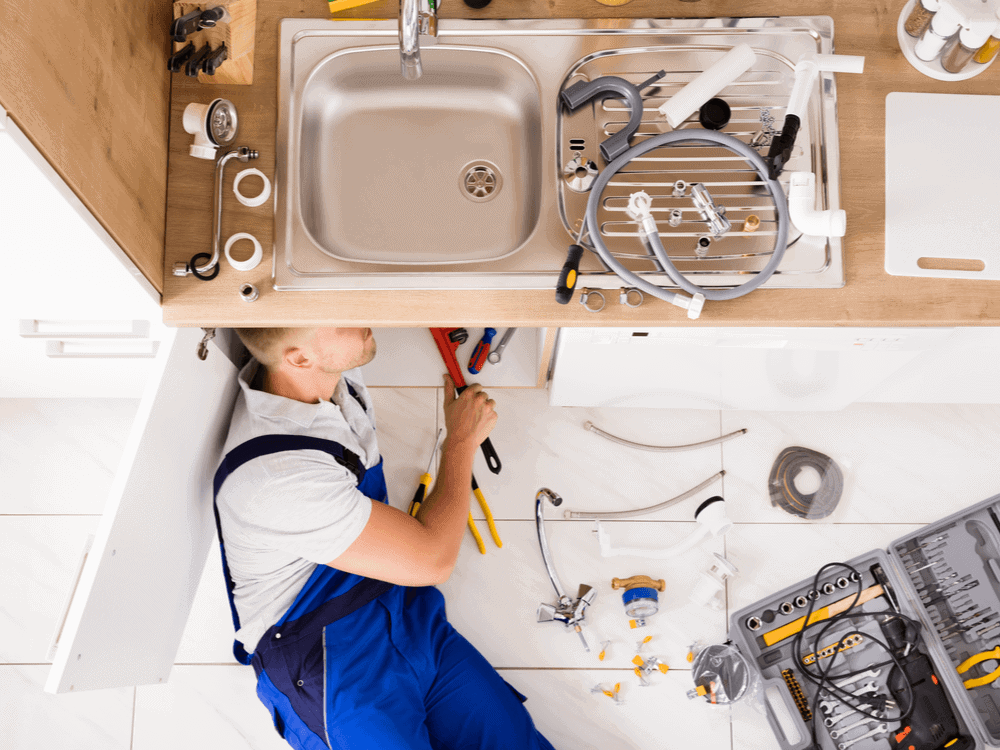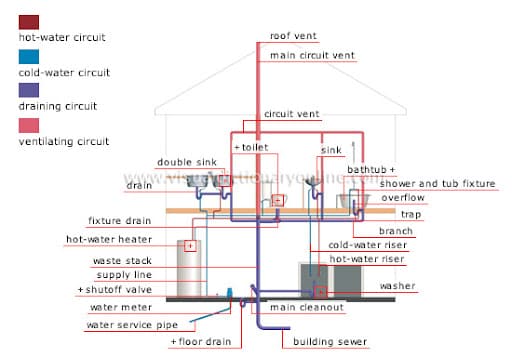A Guide to Your House's Plumbing System Anatomy
A Guide to Your House's Plumbing System Anatomy
Blog Article
On this page underneath you can get more reliable advice related to Anatomy of a House: Understanding the Components.

Recognizing just how your home's pipes system functions is vital for every single property owner. From delivering clean water for drinking, food preparation, and showering to safely getting rid of wastewater, a properly maintained pipes system is vital for your family members's health and convenience. In this thorough overview, we'll check out the elaborate network that makes up your home's pipes and deal ideas on upkeep, upgrades, and taking care of typical problems.
Introduction
Your home's pipes system is greater than just a network of pipes; it's a complex system that guarantees you have accessibility to clean water and efficient wastewater elimination. Understanding its parts and exactly how they collaborate can help you protect against pricey repair services and guarantee whatever runs smoothly.
Standard Parts of a Plumbing System
Pipelines and Tubing
At the heart of your pipes system are the pipes and tubes that carry water throughout your home. These can be constructed from different materials such as copper, PVC, or PEX, each with its advantages in regards to resilience and cost-effectiveness.
Components: Sinks, Toilets, Showers, etc.
Fixtures like sinks, toilets, showers, and bath tubs are where water is utilized in your house. Comprehending how these components connect to the pipes system assists in diagnosing issues and planning upgrades.
Shutoffs and Shut-off Factors
Valves control the circulation of water in your plumbing system. Shut-off shutoffs are crucial throughout emergencies or when you require to make repair work, permitting you to isolate parts of the system without interfering with water flow to the whole house.
Water Supply System
Key Water Line
The primary water line links your home to the metropolitan water or a private well. It's where water enters your home and is distributed to numerous fixtures.
Water Meter and Pressure Regulator
The water meter procedures your water usage, while a stress regulator makes certain that water moves at a risk-free pressure throughout your home's plumbing system, protecting against damages to pipes and fixtures.
Cold Water vs. Warm water Lines
Comprehending the distinction between cold water lines, which supply water straight from the primary, and hot water lines, which lug heated water from the water heater, helps in repairing and preparing for upgrades.
Drain System
Drain Piping and Traps
Drain pipelines carry wastewater away from sinks, showers, and bathrooms to the sewage system or sewage-disposal tank. Catches stop drain gases from entering your home and additionally trap debris that could create blockages.
Ventilation Pipelines
Ventilation pipelines enable air into the drain system, avoiding suction that could slow drainage and create catches to vacant. Appropriate ventilation is crucial for keeping the stability of your pipes system.
Significance of Appropriate Drain
Guaranteeing proper drain protects against backups and water damages. Consistently cleaning up drains and maintaining traps can protect against expensive repairs and expand the life of your plumbing system.
Water Heating Unit
Kinds Of Water Heaters
Water heaters can be tankless or typical tank-style. Tankless heaters heat water as needed, while tanks keep warmed water for prompt use.
How Water Heaters Attach to the Pipes System
Comprehending exactly how water heaters connect to both the cold water supply and warm water circulation lines helps in detecting concerns like not enough hot water or leakages.
Upkeep Tips for Water Heaters
Routinely flushing your water heater to eliminate debris, checking the temperature settings, and inspecting for leakages can expand its life-span and enhance energy performance.
Typical Plumbing Issues
Leakages and Their Causes
Leakages can happen because of maturing pipelines, loose fittings, or high water stress. Attending to leaks without delay stops water damage and mold development.
Clogs and Clogs
Blockages in drains and commodes are typically caused by purging non-flushable products or a buildup of oil and hair. Using drainpipe screens and bearing in mind what decreases your drains can protect against blockages.
Indicators of Plumbing Troubles to Watch For
Low water stress, slow drains pipes, foul odors, or unusually high water expenses are signs of prospective plumbing troubles that should be attended to promptly.
Pipes Upkeep Tips
Regular Examinations and Checks
Arrange annual plumbing examinations to catch concerns early. Seek signs of leakages, corrosion, or mineral accumulation in taps and showerheads.
DIY Maintenance Tasks
Straightforward jobs like cleansing faucet aerators, looking for bathroom leakages making use of dye tablet computers, or protecting revealed pipelines in cold environments can protect against major pipes concerns.
When to Call a Professional Plumbing Professional
Know when a plumbing issue needs specialist know-how. Trying complex repair work without appropriate expertise can lead to more damage and greater fixing costs.
Upgrading Your Plumbing System
Reasons for Upgrading
Updating to water-efficient components or replacing old pipes can improve water high quality, minimize water costs, and raise the value of your home.
Modern Plumbing Technologies and Their Benefits
Check out innovations like wise leakage detectors, water-saving bathrooms, and energy-efficient hot water heater that can conserve cash and reduce environmental impact.
Cost Considerations and ROI
Calculate the in advance expenses versus long-lasting cost savings when thinking about pipes upgrades. Lots of upgrades pay for themselves via lowered energy costs and less repair services.
Ecological Effect and Preservation
Water-Saving Components and Home Appliances
Setting up low-flow faucets, showerheads, and bathrooms can considerably decrease water use without sacrificing efficiency.
Tips for Lowering Water Use
Basic routines like repairing leaks immediately, taking shorter showers, and running full loads of washing and meals can save water and lower your utility bills.
Eco-Friendly Pipes Options
Take into consideration lasting plumbing products like bamboo for floor covering, which is durable and green, or recycled glass for kitchen counters.
Emergency Preparedness
Actions to Take Throughout a Plumbing Emergency
Know where your shut-off shutoffs are located and how to switch off the water in case of a ruptured pipe or major leak.
Importance of Having Emergency Contacts Handy
Maintain get in touch with info for neighborhood plumbing professionals or emergency services easily available for fast reaction during a plumbing situation.
DIY Emergency Situation Fixes (When Suitable).
Short-term fixes like utilizing air duct tape to patch a leaking pipeline or putting a bucket under a dripping faucet can reduce damage till an expert plumbing technician shows up.
Conclusion.
Recognizing the makeup of your home's pipes system empowers you to keep it successfully, saving money and time on repairs. By complying with routine upkeep routines and staying educated about modern-day plumbing modern technologies, you can ensure your plumbing system runs efficiently for many years ahead.
Exploring Your Homes Plumbing Anatomy
Water Supply System
Main Water Line: This is where water enters your home from the municipal supply or a private well.
Water Meter: Typically located near where the main water line enters the property, it measures the amount of water used.
Shutoff Valve: It s crucial to know where this is in case of emergencies. It allows you to turn off the water supply to the entire house.
Pipes and Fittings: These distribute water throughout your home. Materials can include copper, PVC, or PEX.
Drain-Waste-Vent (DWV) System
Drains: Located in sinks, showers, and tubs, these carry wastewater away.
Traps: U-shaped pipes under sinks that hold standing water, blocking sewer gases from entering the home.
Vents: Pipes that lead from the DWV system to the outside, preventing vacuum formation and allowing gases to escape.
Sewer Line: Carries all wastewater from the home to the municipal sewer system or a septic tank.
Fixtures and Appliances
Sinks, Toilets, and Showers
Dishwashers and Washing Machines
Water Heaters
Maintenance Tips
Regularly check for leaks in exposed pipes and around fixtures.
Inspect the water heater annually for signs of wear.
Clean drains and traps to prevent clogs and odors.
Know how to shut off water to individual fixtures.
When to Call a Professional
Major leaks or burst pipes
Installation of new pipes or fixtures
Septic tank issues
Remodeling projects that involve plumbing changes
Conclusion
Understanding the anatomy of your home's plumbing is key to maintaining a functional and efficient system. Regular checks and knowing when to call in the experts can save you time, money, and stress.
https://www.mavyn.com/blog/exploring-your-homes-plumbing-anatomy

Exploring Your Homes Plumbing Anatomy
Water Supply System
Drain-Waste-Vent (DWV) System
Fixtures and Appliances
Maintenance Tips
When to Call a Professional
Conclusion
Understanding the anatomy of your home's plumbing is key to maintaining a functional and efficient system. Regular checks and knowing when to call in the experts can save you time, money, and stress.
https://www.mavyn.com/blog/exploring-your-homes-plumbing-anatomy
Do you really like reading up on Anatomy of a House: Understanding the Components? Write a remark below. We'd be pleased to hear your responses about this posting. Hoping to see you back again soon. Feel free to take the time to share this blog post if you enjoyed it. I recognize the value of your readership.
Book My Estimate Report this page